Crustal Architecture and Images

|
IGCP Project 559
Crustal Architecture and Images |
 |
|
contact us: [email protected] | about us
|
34th International
|
Updated: Oct 13, 2010 IGCP Project 559 - Seismic ImagesCrustal Architecture of the East African Rift SystemA review compiled by [email protected]
BackgroundThe East African Rift is the largest continental rift system on Earth. It extends from Lebanon in the north, along the Red Sea and through Sudan, Ethiopia, Kenya, Tanzania to Mozambique. A number of web sites with articles/papers/information on the rift are presented in: http://www.geolor.com/East_African_Rift_Valley_geolor.htm 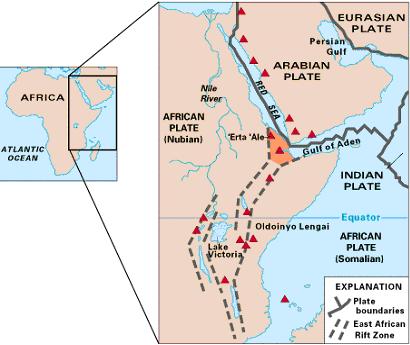
Figure 1 – Map of East Africa showing some of the historically active volcanoes (red triangles) Most of the seismic investigations of crustal structure within the rift system to date have involved wide-angle seismic profiling with shot-to-recorder offsets of more than 400-700 km in places. EAGLE (Ethiopia-Afar Geoscientific Lithospheric Experiment):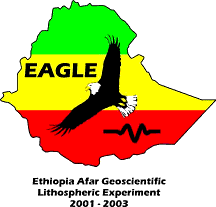 An investigation to examine the issues surrounding modification of lithospheric structure during continental break-upSituated where the southern Red Sea and the Gulf of Aden meet the East African Rift, Ethiopia is one of the very few places on Earth where geologists can study the active process of stretching of the continental plate and associated volcanism and tectonic activity, prior to flooding by a newly formed sea. The EAGLE field work is focussed on the Ethiopia-Red Sea-Gulf of Aden region.
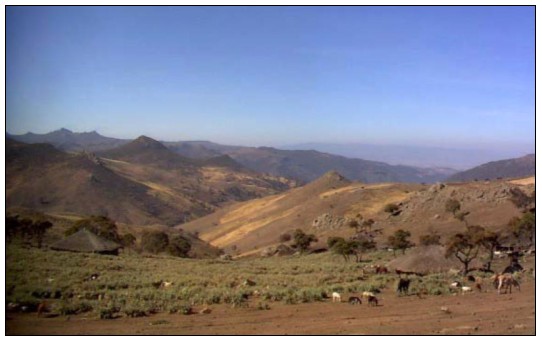 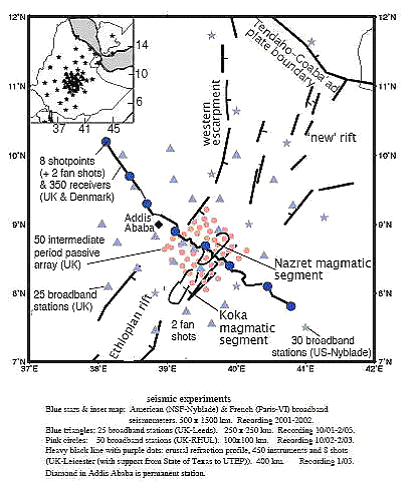
Some of the questions being asked are:
Answers to Questions 1-3 above will allow us to distinguish between models of continental break-up, resolving, at least for the Main Ethiopian Rift, the controversy: Do border faults serve as incipient lithospheric-scale detachments or do asthenospheric upwellings supply magma to crustal reservoirs, enabling strain accommodation by diking similar to oceanic rifts? 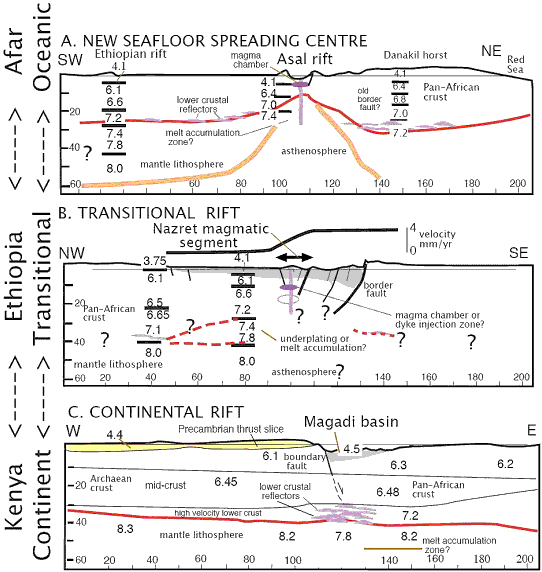
Comparison of crustal structure, Afar-Ethiopia-Kenya. Hypothesized crustal cross-sections, Shaded regions (in image above) are anomalously low-velocity zones interpreted as melt accumulations. B) corresponds to the proposed study area: deep structure is highly conjectural.
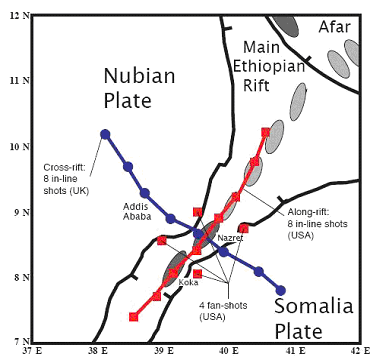 Proposed wide-angle seismic profiling lines, 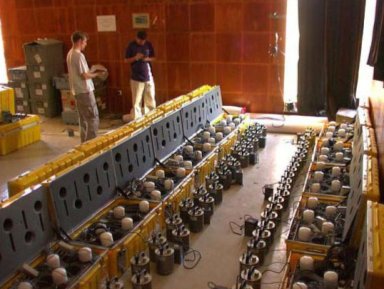 Equipment testing: University of Leicester, UK 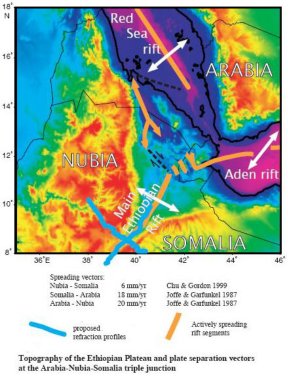 Structure and Evolution of the Main Ethiopian RiftSimon Klemperer – Stanford University http://prodev.iris.edu/OnePagers/klemperer2.pdf The Ethiopia Afar Geoscientific Lithospheric Experiment (EAGLE) was undertaken in 2003 by an international team composed primarily of U.S., British and Ethiopian scientists and students to provide a snapshot of lithospheric breakup at the transition between continental and oceanic rifting. Our focus is the Main Ethiopian Rift (MER) that extends from central Ethiopia into Afar towards the Gulf of Aden and Red Sea oceanic rifts. The MER cuts across the uplifted Ethiopian plateau, which is a major Oligocene flood basalt province associated with the impact of the Afar mantle plume. 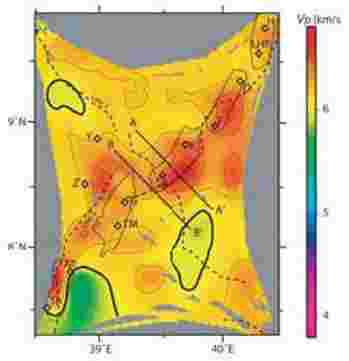 Horizontal slice through the 3-D tomographic model at 10 km below the surface Keranen, K., Klemperer, S.L., Gloaguen, R. & the EAGLE Working Group, Imaging a protoridge axis in the Main Ethiopian Rift, Geology, 32(11), 949 – 952, 2004. Maguire, P., Ebinger, C., Stuart, G., Mackenzie, G., Whaler, K., Kendall, J.-M., Khan, M., Fowler, C., Klemperer, S., Keller, G., Harder, S., Furman, T., Mickus, K., Asfaw, L., Ayele, A.,& Abebe, B., Geophysics project in Ethiopia studies continental breakup. EOS (Transactions American Geophysical Union), 84(35), 342-343, 2003. Seismicity of the northern Main Ethiopian riftD.Keir(1), C.Ebinger(1), G.Stuart(2), E.Daly(3), A.Ayele(4)
See also: Keir, D; Ebinger, CJ; Stuart, GW; Daly, E; Ayele, A (2006) Strain accommodation by magmatism and faulting as rifting proceeds to breakup: Seismicity of the northern Ethiopian rift, J GEOPHYS RES-SOL EA, 111(B5), . doi:10.1029/2005JB003748and Daly, E; Keir, D; Ebinger, CJ; Stuart, GW; Bastow, ID; Ayele, A (2008) Crustal tomographic imaging of a transitional continental rift: the Ethiopian rift, GEOPHYS J INT, 172(3), pp1033-1048. doi:10.1111/j.1365-246X.2007.03682.x 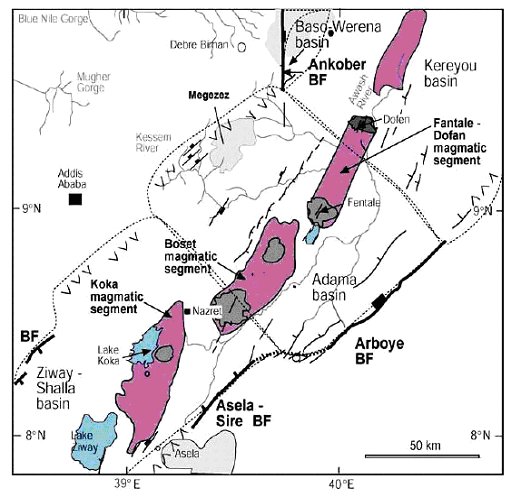 Major faults and magmatic segments of the northern Main Ethiopian rift (Wolfenden et al, 2004). The northern Main Ethiopian rift (MER) developed within the Paleogene flood basalt province of NE Africa, and forms the youngest arm of the Afar triple junction. High angle, large-offset border faults formed after 12Ma, providing a linkage between the East African rift system and the southern Red Sea-Gulf of Aden rifts (Wolfenden et al, 2004). However, active subsidence migrated to a narrower zone in the central rift by 3.5Ma. Since 1.8Ma magmatism and faulting has become more localized to ~20km-wide, 60km-long 'magmatic segments' marked by aligned eruptive centers, fissures, and small offset normal faults. This pattern of faulting and magmatism indicates that the East African rift system in Ethiopia is in a stage of development that is transitional between continental and oceanic in style (Ebinger & Casey, 2001) Ebinger, C.J., Casey, M. Continental breakup in magmatic provinces: An Ethiopian example. Geology, v.20, no. 6, p. 527-530. 2001. Maguire, P., and 15 others. Geophysical project in Ethiopia studies continental Breakup. Eos, Transactions of the American Geophysical Union, v. 84, p. 337, 342-343, 2003. Waldhauser, F. & Ellsworth, W.L. A double-difference earthquake location algorithm: Method and application to the northern Hayward fault. Bull. Seismol. Soc. Am., v.90, p.1353 – 1368, 2000. Wolfenden, E., C. Ebinger, G. Yirgu, A. Deino, D. Ayalew. 2004. Evolution of the northern Main Ethiopian rift: Birth of a triple junction, Earth Planet. Sci. Letts., 2004. 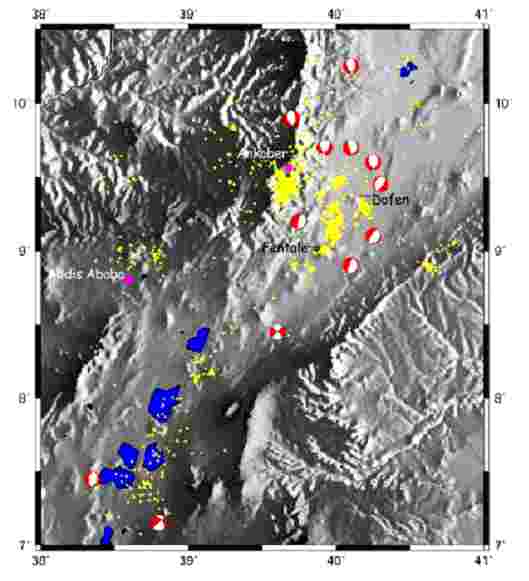 Seismicity of the EAGLE project study area October 2001 – January 2003. Selected bibliographyAbbate, E., Passerini, P. and Zan, I., 1995. Strike-slip faults in a rift area - a transect in the Afar triangle, East-Africa. Tectonophysics, 241: 67-84 Baker B.H., Mohr, P.A., and Williams, L.A.J., 1972. Geology of the East Africa rift system, Geol. Soc. America Spec. Paper, 136, 67 pp. Beydoun, Z.R., 1996. Rift sedimentation and tectonics in the Red Sea and Gulf of Aden region. Journal of Petroleum Geology, 19: 235-245. Birt, C., Maguire, P., Khan, M., Thybo, H., Keller, G. & Patel, J., 1997. The influence of pre-existing structures of the southern Kenya rift valley: evidence from seismic and gravity studies, Tectonophyics, 278, 211-242. Bosworth, W. and Maurin, A., 1993. Structure, geochronology and tectonic significance of the Northern Suguta Valley (Gregory rift), Kenya. Journal of the Geological Society, London, 150: 751-762. Bosworth, W., 1994. A model for the 3-dimensional evolution of continental rift basins, northeast Africa. Geologische Rundschau, 83(4): 671-688. Braile, L.W., Wang, B., Daudt, C.R., Keller, G.R., and Patel, J.P., 1994. Modelling the 2-D seismic velocity structure across the Kenya rift. In: C. Prodehl, G.R. Keller, and M.A. Khan (Editors), Crustal and upper mantle structure of the Kenya rift. Tectonophysics, 236: 251-269. Chorowicz, J., Collet, B., Bonavia, F.F. and Korme, T., 1994. Northwest to north-northwest extension direction in the Ethiopian rift deduced from the orientation of extension structures and fault-slip analysis. Geological Society of America Bulletin, 106(12): 1560-1570. Ebinger, C.J., 1989. Tectonic development and the western branch of the East African rift system. Geol. Soc. of Am. Bull., 101, 885-903. Ebinger and Casey, 2001. Continental break-up in magmatic provinces: an Ethiopian example. Geology, 29, 527-530. Ebinger C.J. and Ibrahim A., 1994. Multiple episodes of rifting in Central and East Africa: A re-evaluation of gravity data. Geol. Rundsch. 83, 689-702. Ebinger, C. and Sleep, N., 1998. Cenozoic magmatism throughout E Africa resulting from impact of a single plume. Nature, 395, 788-791. Ebinger, C.J. 1989. Geometric and kinematic development of border faults and accommodation zones, Kivu-Rusizi rift, Africa, Tectonics, 8, 117-133. Ebinger, C., T. Yemane, D. Harding, S. Tesfaye, D. Rex, S. Kelley, Rift deflection, migration, and propagation: Linkage of the Ethiopian and Eastern rifts, Africa, Geol. Soc. Amer. Bull., 102, 163-176, 2000. Foster, A., Ebinger, C., Mbede, E. and Rex, D., 1997. Tectonic development of the northern Tanzanian sector of the East-african rift system. Journal of the Geological Society, London, 154: 689-700. Hay, D.E., R.F. Wendlandt, and G.R. Keller, 1995, The origin of Kenya rift Plateau-type flood phonolites: Integrated petrologic and geophysical constraints on the evolution of the crust and upper mantle beneath the Kenya rift: Journal of Geophysical Research, 100, 10,549-10,557. Jestin, F., Huchon, P. and Gaulier, J.M., 1994. The Somalia plate and the East-African rift system - present-day Kinematics. Geophysical Journal International, 116(3): 637-654. Keller, G.R., Mechie, J., Braile, L.W., Mooney, W.D. and Prodehl, C., 1994. Seismic structure of the uppermost mantle beneath the Kenya Rift. In: C. Prodehl, G.R. Keller and M.A. Khan (Editors), Crustal and upper mantle structure of the Kenya rift. Tectonophysics, 236: 201-216. Keller, G. R., C. Prodehl, J. Mechie, K. Fuchs, M. A. Khan, P. K. H Maguire, W. D. Mooney, U. Achauer, P. M. Davis, R. P. Meyer, L. W. Braile, I. O. Nyambok, & G. A. Thompson, 1994. The East African rift system in the light of KRISP 90. In Crustal and Upper Mantle Structure of the Kenya Rift, C. Prodehl, G. R. Keller and M. A. Khan (eds.), Tectonophysics, v. 236, p. 465-483. Makris, J., Menzel, H., Miller, H. & Vees, R. 1975. Deep seismic soundings in the Afar region and on the highland of Ethiopia, in Afar Between Continental and Oceanic Rifting, edited by A. Pilger and A. Rösler, Schweizerbart, Stuttgart, pp.89-107. Smith, M. and Mosley, P., 1993. Crustal heterogeneity and basement influence on the development of the Kenya rift, East-Africa. Tectonics, 12: 791-. Mechie, J., Keller, G.R., Prodehl, C., Gaciri, S., Braile, L.W., Mooney, W.D., Gajewski, D. and Sandmeier, K.-J., 1994. Crustal structure beneath the Kenya Rift from axial profile data. In: C. Prodehl, G.R. Keller and M.A. Khan (Editors), Crustal and upper mantle structure of the Kenya rift. Tectonophysics, 236: 179-200. Mohr, P., 1992. Nature of the crust beneath magmatically active continental rifts. Tectonophysics, 213: 269-284. Morley, C.K., Wescott, W.A., Stone, D.M., Harper, R.M., Wigger, S.T., and Karanja, F.M., 1992. Tectonic evolution of the northern Kenyan rift. J. Geol. Soc. Lond., 149: 333-348. Prodehl, C., and Mechie, J., 1991. Crustal thinning in relationship to the evolution of the Afro-Arabian rift system - a review of seismic-refraction data. In: Makris, J., P. Mohr, and R. Rihm, (Editors), Red Sea: Birth and early history of a new oceanic basin. Prodehl, C., Mechie, J., Achauer, U., Keller, G.R., Khan, M.A., Mooney, W.D., Gaciri, S.J., and Obel, J.D. 1994b. The KRISP 90 seismic experiment – a technical review. Tectonophysics, 236, 33-60. Simiyu, S. M. and G. R. Keller, 1997, An integrated analysis of lithospheric structure across the East African Plateau based on gravity anomalies and recent seismic studies: Tectonophysics, v. 278, p. 291-313. Smith, 1994. Stratigraphic and structural constraints on mechanisms of active rifting in the Gregory rift, Kenya. Tectonophysics, 236(1-4): 3-22. WoldeGabriel, G., Aronson, J. & Walter, R. 1990. Tectonic development of the Main Ethiopian rift, Geol. Soc. Amer. Bull, 102, 439-458. |
| Disclaimer | Copyright | |